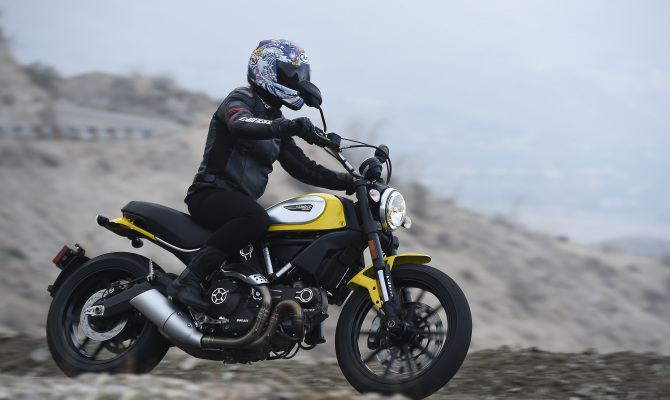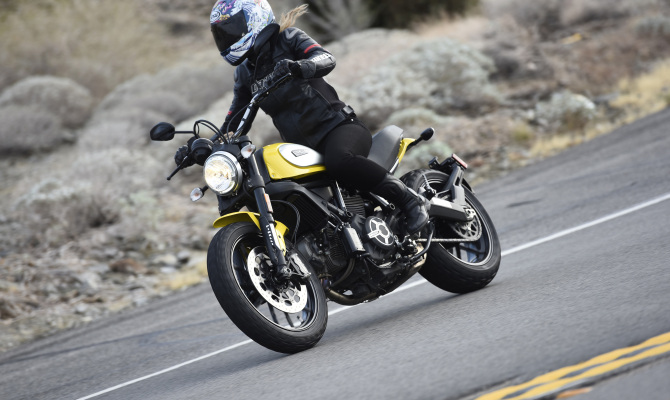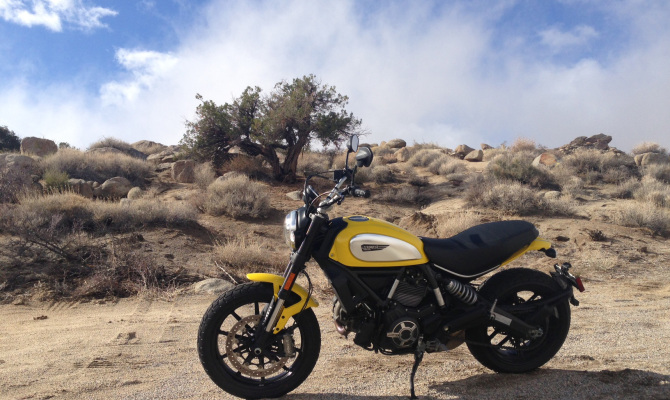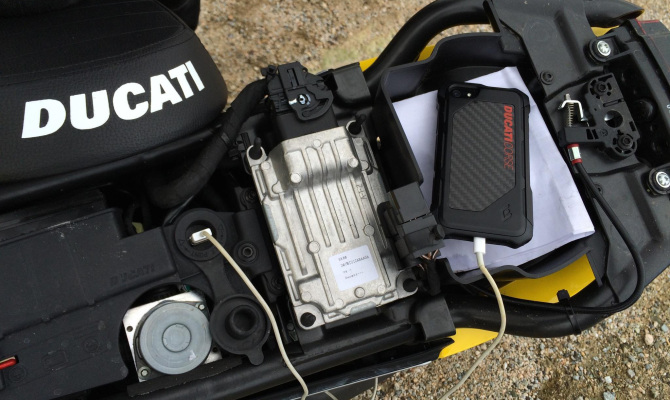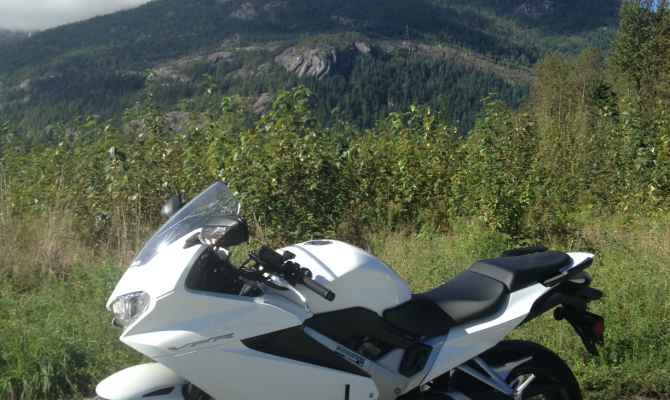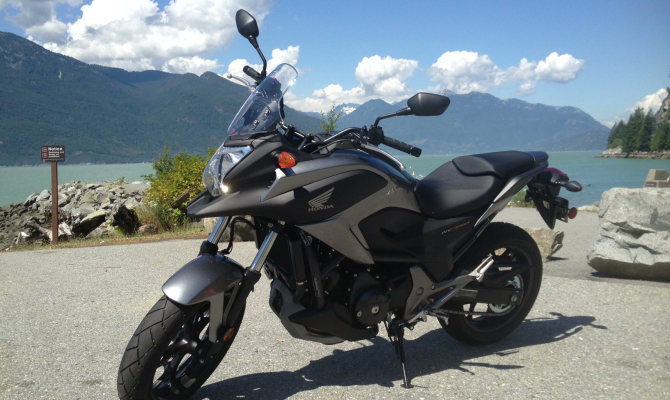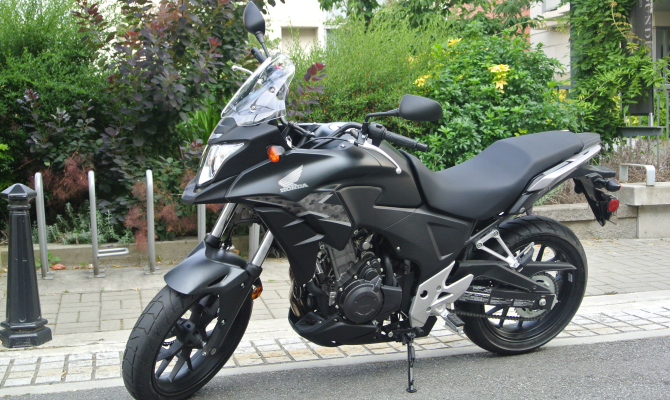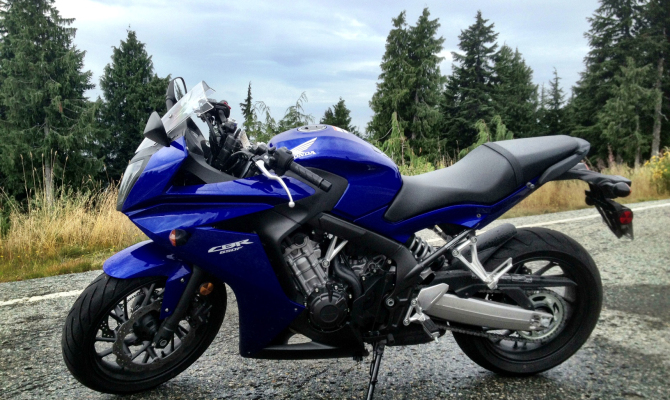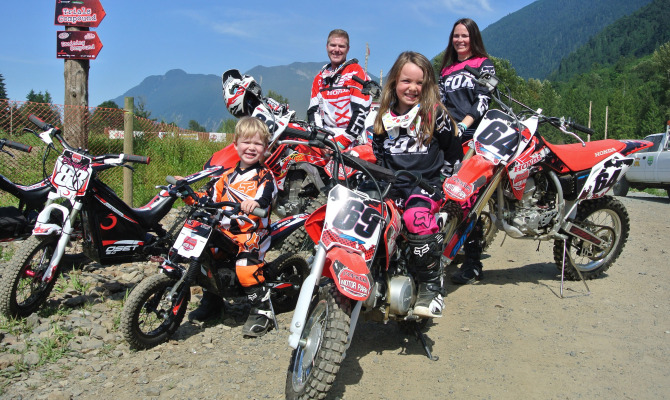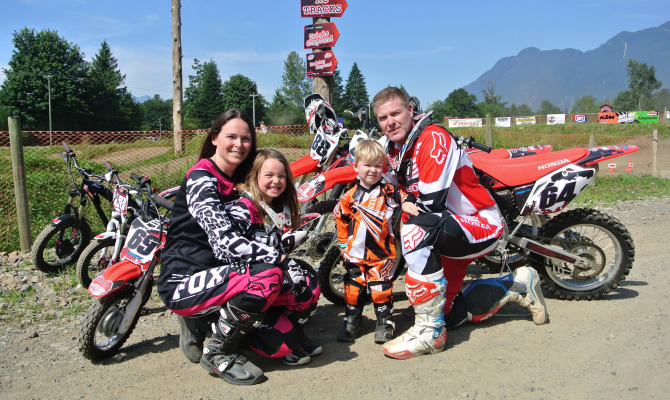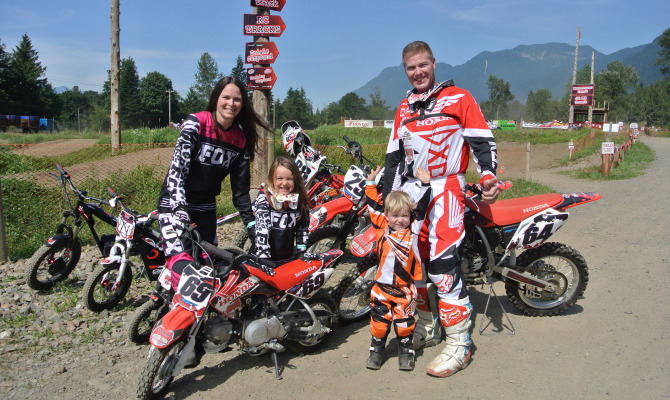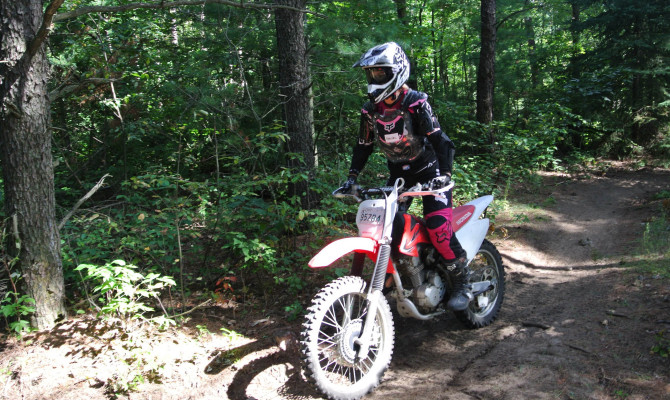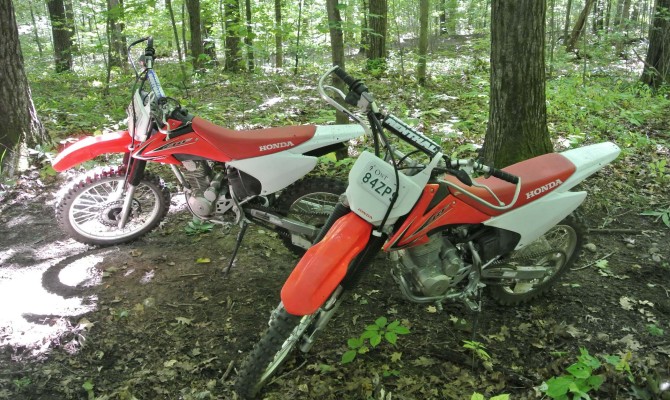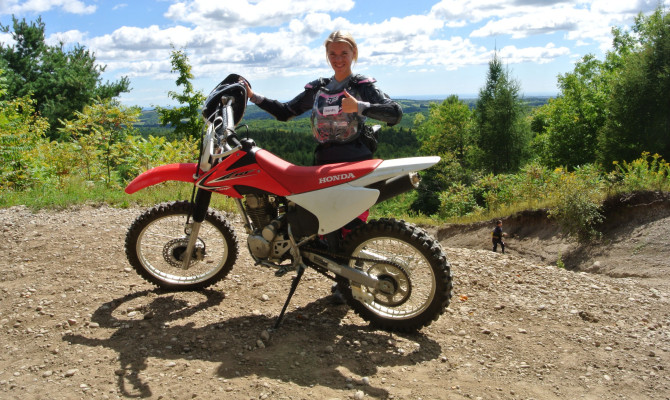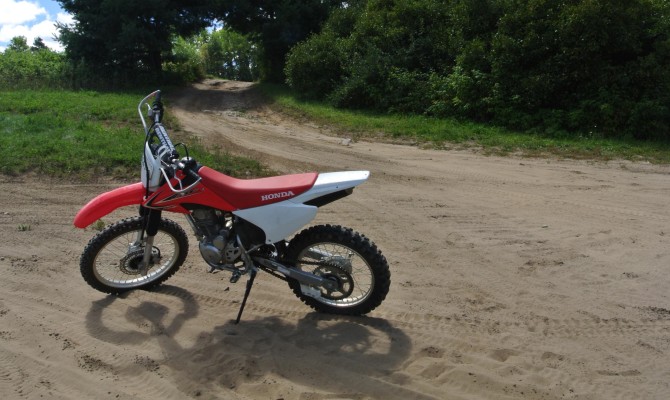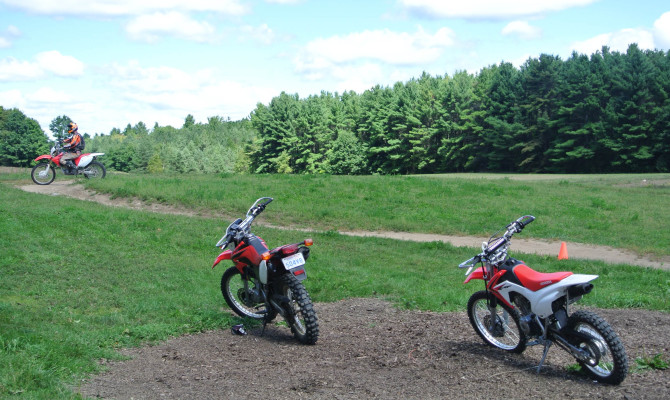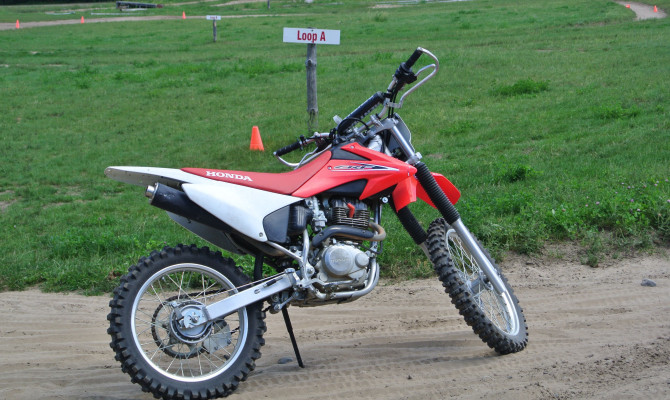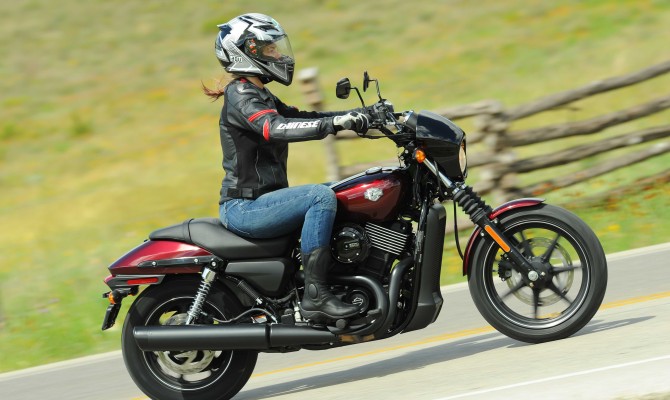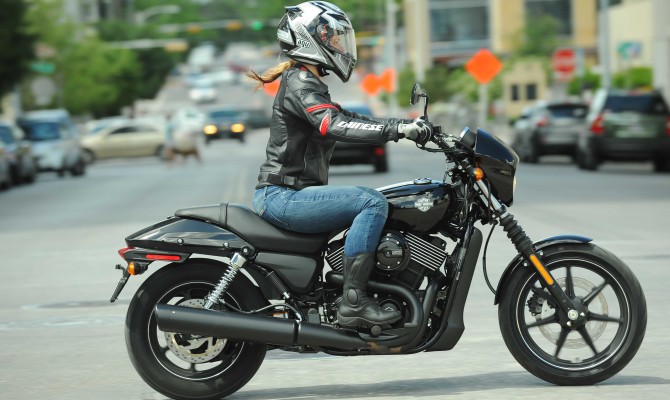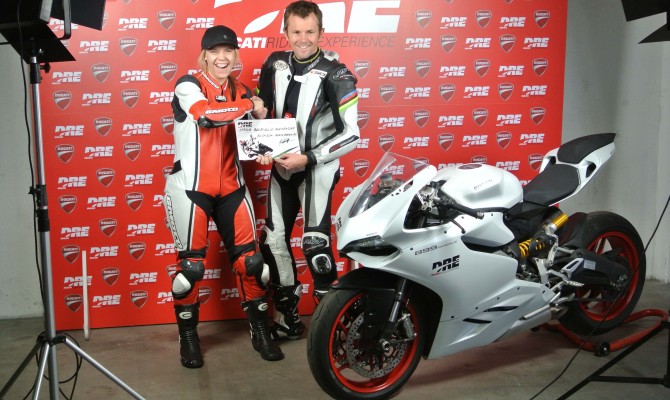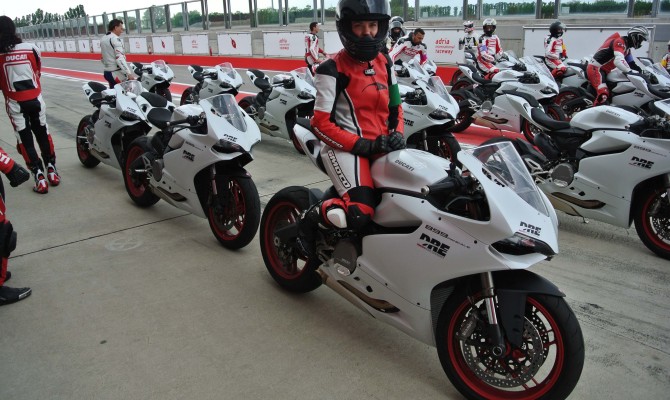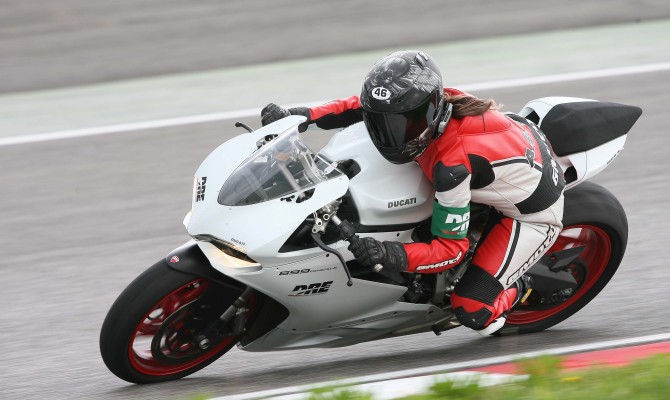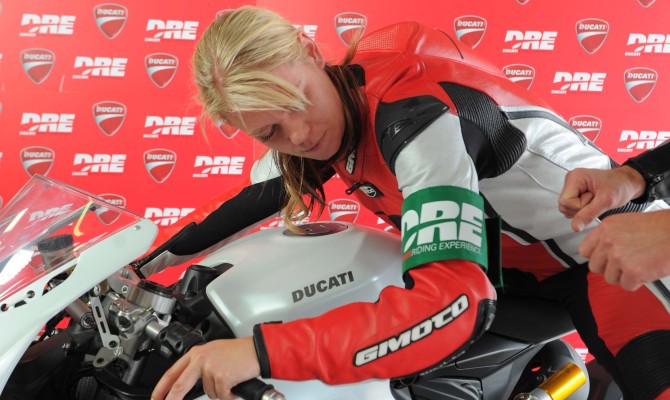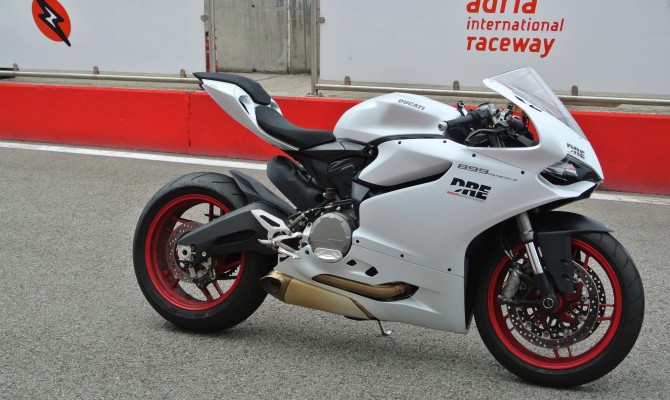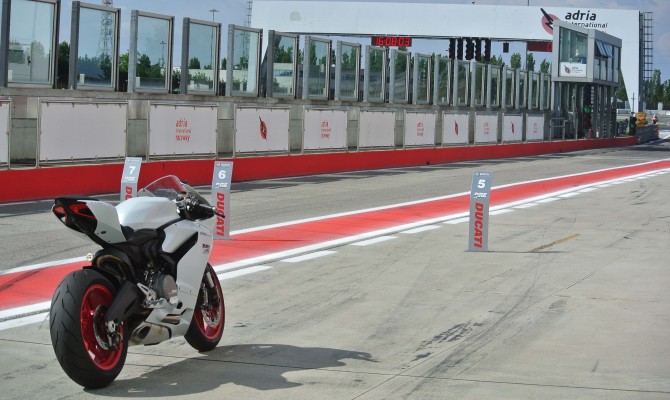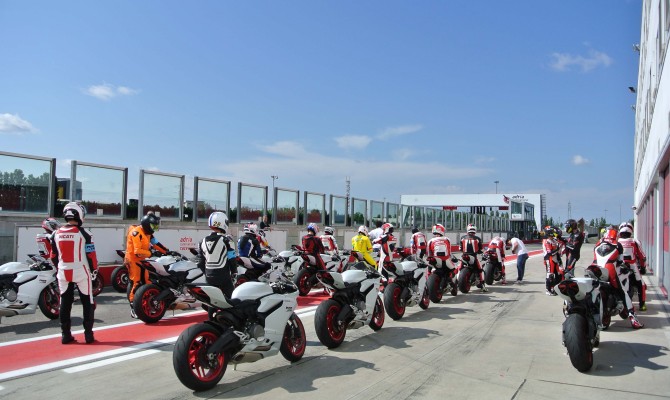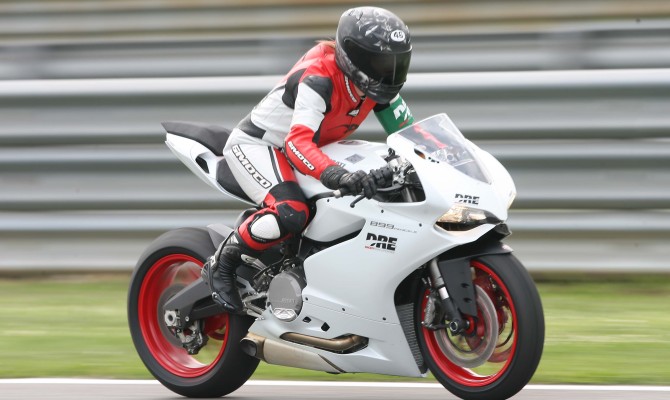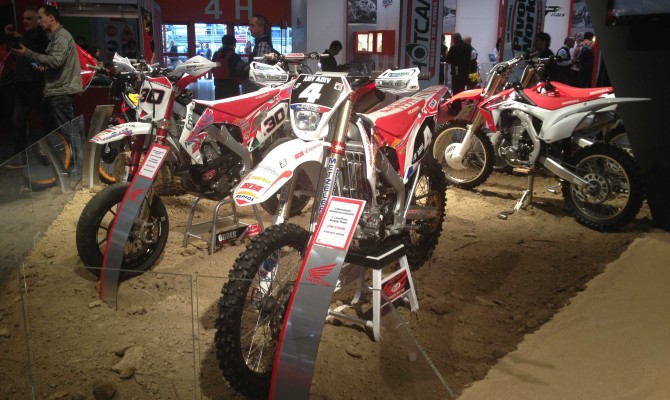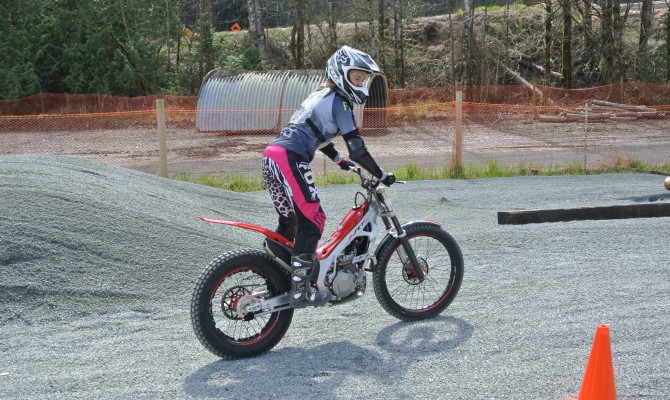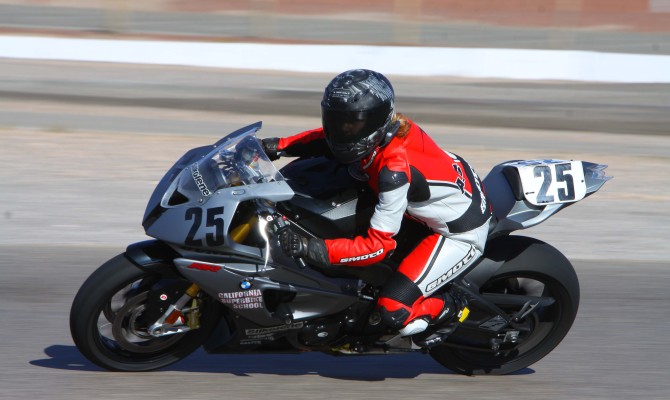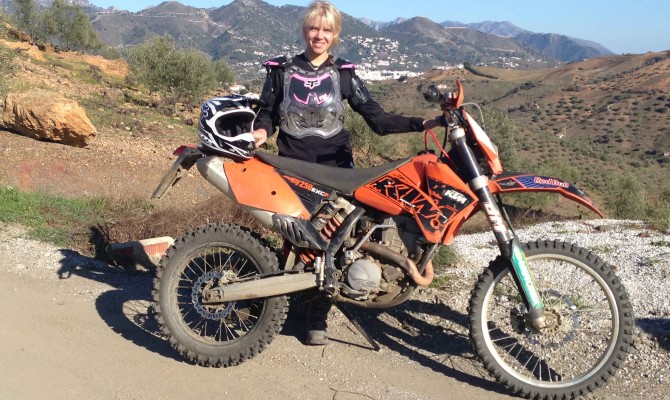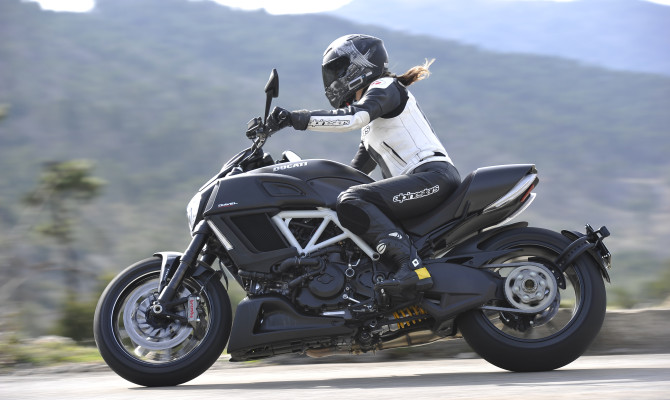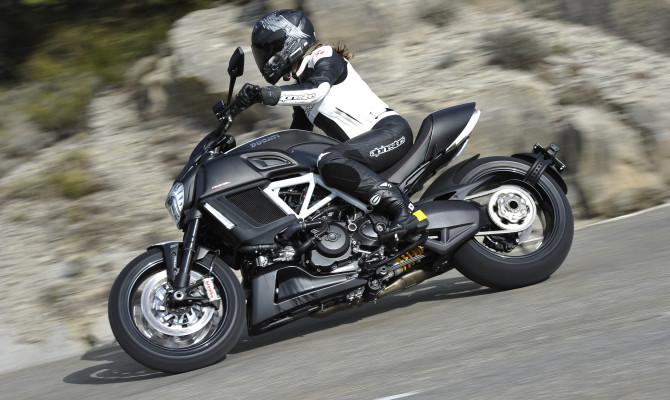Crashes involving motorcyclists increase in summer. If you’re a driver waiting to make a left turn, look for oncoming motorcycles and yield right of way. If you’re a rider, protect yourself from serious injuries – wear an approved helmet and safety gear designed for riding.
Palm Springs, California.
Ask any Ducati owner why they bought their bike and chances are, they won’t say it’s because they got a great deal.
They probably won’t even say it’s because they wanted something sexy and Italian.
It could be because they wanted a state-of-the-art electronics system on an extremely competent road and track-ready motorcycle. Maybe they wanted to experience a piece of the Bologna-based bike brand’s racing pedigree or maybe even because they’re just plain cool.
I’d say those are good reasons, but one reason may trump the aforementioned few. Ducati isn’t merely a brand, it’s a lifestyle. That’s not a new concept for the motorcycle industry.
I can name a certain American motorcycle maker that has this notion nailed down better than a floorboard to a joist. Harley-Davidson, of course.
Then again, so does Ducati. In a different way.
Push the t-shirts, hats, and baby onesies aside and you have a following that grows stronger by the day. And by each bike they introduce. Enter the 2015 Ducati Scrambler.
While it might not have all the electronics the Ducatisti have become accustomed to, or the beautiful bodywork that makes jaws drop, it has a cool factor that compensates for it. Among other things.
With the introduction of this bike – well, technically there are four variations of the Scrambler, but for brevity purposes, I’ll refer to it as one – Ducati is targeting younger riders, or riders who want to experience a bike that serves as a hip and modern motorcycle yet pays homage to the Scramblers of old. The ones from the early 1960s.
Fast forward to now. In front of me is one of four models: the Icon. At a starting MSRP of $9,299, it comes clad in either yellow or red. Other models include Full Throttle ($9,995), the Classic ($10,995) and the Urban Enduro ($10,995.)
All Scramblers have identical chassis and engine specs but styling cues, handlebar configurations, seat covers and a few other aesthetic differentiators distinguish each model.
Up front on the Icon you’ve got a 10-spoke alloy wheel with an 18-inch tire and around back, a 17-inch tire. This set of rubbers was developed specifically for the bike with Pirelli and allow some hooliganism to happen both on and off road. But do keep in mind, it’s not designed specifically for off-road use.
The Scrambler scrambles to the tune of an air-cooled, L-Twin cylinder, 803cc
engine. It’s the same engine that occupied the space of the Monster 796 but has be detuned for this bike. Though, 75 horsepower and 50 lb-ft of torque is nothing to scoff at, especially if the bike is targeted at those who want to romp the urban streets.
Perhaps one of the coolest features of this bike is the underseat storage area with a USB port. While you ride, you can keep your phone charging and out of the way so you’re not distracted.
Letting you know what’s going on with the bike is a large, circular, LCD display that’s easy to read and offset to the right.
The steel teardrop-shaped tank with interchangeable aluminum side panels holds 13.5L of fuel and the wet weight of the bike tips the scale at 186 kg (410 lb.)
With a 790 mm (31.1-inch) seat height and an available as accessory low seat 770 mm (30.3-inch), both its weight and seat height are welcoming attributes for both seasoned and rookie riders.
Atop this sunshine-hued motorcycle, the wide seat is cushy, the handlebars are at a comfortable height and I’m ready to take this Icon for a spin.
Engaging the cable-actuated clutch, over time, did give my left hand a good workout. So did shifting through the 6-speed gearbox. After a long, and cold day’s ride, gears started to feel notchy and false neutrals prevailed. You could attribute that to the weather or the fact that the bikes were basically brand new.
Nevertheless, that didn’t stop me from thoroughly enjoying myself. The Scrambler’s strong suit is in its handling. You don’t need to continually adjust it to find an ideal apex on twisty roads and then stay there. Its suspension isn’t jarring, nor does it squirm under slippery situations.
Up front, a single 330 mm disc, radial 4-piston caliper with ABS is standard equipment and can bring you to a stop with minimal input.
Low-end torque, plus a predictable nature allows you to accelerate quickly but keep a snail’s pace if you’re stuck in stop-and-go traffic.
Overall, the Scrambler has a few kinks but that doesn’t distract me from praising its all-encompassing appeal. As for a lifestyle product, you can personalize it to the nth degree and even get the gear, t-shirts, hats and more to match.
And it’s just plain cool.
Visit http://scramblerducati.com/en for more information.
“We might be deep into fall – with the accompanying frigid temperatures – but on sunny days, the roads aren’t without motorcycles…”
Honda has had a big year.
Not only did it bring back the popular VFR800F (which I’ll get to in a bit), they released some all-new products.
But the fun isn’t stopping there. With more motorcycles on the way for 2015, I thought now would be a good time to look back at some great bikes I rode in 2014.
Besides, we might be deep into fall – with the accompanying frigid temperatures – but on sunny days, the roads aren’t without motorcycles. That’s definitely a warming thought.
CBR650F
Don’t let the “CBR” designation – followed by the 650 – intimidate you. This all-new middleweight bike has the sporty flair that you’re used to but with a twist.
With a curb weight of 211kg (465 lbs.) and a seat height is 810mm (31.8-inches), complete with a narrow middle profile, it allows a range of riders to feel comfortable atop its seat.
What I really liked about this bike is that yes, you have the sport bike styling, but without the wrist and backache that can sometimes be experienced. The ergonomics are more upright so I was comfortable for much longer when I decided to go for an extended ride.
Honda mentions that the development team included many engineers in their 20s.
That’s a good thing, considering they want to attract a younger customer with the CBR650F.
Furthermore, engineers decided early on that chasing peak power at redline was off their agenda. Strong acceleration from a standing start, low/mid range torque and mid-gear roll-on throttle response were targeted as the essential elements.
Speaking of which, it’s powered by a liquid-cooled, 4-stroke, DOHC, inline-4 engine.
It comes in great colours like Sword Silver Metallic, and my test bike, which happened to be the eye-catching Candy Tahitian Blue
The CBR650F has an MSRP of $8,999.
VFR800F
The wait is over and 2014 saw the re-introduction of the VFR800F.
The legendary motorcycle is completely updated with a modern look, a brand new telescopic fork, Pro-arm swingarm, wheels and bodywork.
Not to mention, there’s an adjustable seat height, standard-fit Traction Control System, ABS, heated grips and Honda’s unique new self-cancelling turn signals.
In the process, it sheds 10kg from the previous model, and has an engine re-tuned for greater low and mid-range torque.
The V4 engine configuration, which powers this sport-touring machine is unique to Honda and dates back four decades.
The 782cc, liquid-cooled, DOHC 90° V4-VTEC engine allows for some great low-end power, but rev it higher and you dig into the VTEC, which will really put a smile on your face.
Much like the VTEC in Honda vehicles, VTEC valve timing still operates one pair of inlet/exhaust valves per cylinder at low rpm, and then switches to four as revs rise but the transition is now seamless.
The seat is height adjustable (789mm/31-inches or 809mm/31.8-inches) using the tool provided and it weighs in at 239kg (527 lbs.)
It’s not a svelte bike by any stretch, so urban riding wasn’t my favourite. But on the open road, it is just a treat.
It has an MSRP of $13,499.
NC750XA
Ah, the NC750XA. A bike I’ve been dying to get on since the NC700s came out two years ago.
It’s the more adventurous of two NC models (the S and X), with a taller ride height (830mm/32.6-inches in comparison to 790mm/31.1-inches) and a more upright seating position.
This “different” breed of bike isn’t the high redlining sort Honda riders might be used to. It’s ideal for urban romping or a pleasure cruise.
For 2014, an extra 75cc capacity was added to the liquid-cooled, SOHC 8-valve parallel twin- cylinder engine.
With its engine mounted low to the ground, it naturally equates to a low centre of gravity and an easy-to-move-around type of riding dynamic. Furthermore, you can get upwards of 400km out of the 14L tank. Not bad.
And it get’s better.
With the fuel tank under the seat, you have that allows for a handy storage compartment in place of where you’d normally put in your gas; one of the coolest features of this bike.
It has an MSRP of $8,199.
CB500XA
One member of the CB500 trifecta, the 500XA, is a charming little bike that fulfills the idea of owning an adventure-style bike but one that is more manageable for newer riders in the genre. It has a compact adjustable windscreen, open riding accommodations and large-capacity fuel tank.
It has an MSRP of $6,049.
“You value time together more when you’re all doing something that you all love. As a full-time working mom, I’m so grateful we have riding as a common bond.”
With the distractions of technology, smartphones, television programming, life, video games and more, it can be tough to find an activity in which the whole family can participate let alone enjoy.
Age differences between children, gender, and general interests can vary greatly.
My brother and I couldn’t be more opposite. Rest assured, there is hope and some of it comes in the form of two wheels. (more…)
Ganaraska Forest, Ontario.
“Remember, the trees don’t move,” coaches Al Lakas, chief instructor at Trail Tours.
These words offer some solace but little consolation to the confines of singe-track riding.
Claustrophobia is not a regularly referenced noun in my vocabulary, but when the local fauna and flora of the Ganaraska Forest are a hair’s length from your body, and the trail is inches wider than the handlebars of your bike, it’s hard to ignore.
The Medusa-like temptation to fixate on upcoming vegetation must be overcome. If you do happen to focus on them, it could be game over.
“Oh, shoot, there’s a stum…”
Thud.
There goes the front end of your bike, and probably you.
If you look down, your handlebars might do a jig-like dance, and chances are, that’s where you end up. Down.
Breathing through the anxiety is one way of conquering the trails. Another is a strong foundation in riding. But the most important of them all: vision.
Before heading out onto the over 300 kilometres of trails nestled within the 11,000 acres of Ganaraska Forest, Trail Tours instructor Al gives my riding partner and I a lesson in a much less confining location.
Thank goodness.
Nestled in the heart of the seemingly limitless dirt biking and motorized vehicle playground is Trail Tours (www.trailtour.com.) It’s just over an hour’s drive east from Toronto and well worth the short-haul journey. After parking the car and walking a few paces through a trail, the world gets a little brighter. Literally and metaphorically.
The sinewy trees – well, in comparison to west coast wood – that lead us to home base doesn’t let in a ton of light, so at the end of the trail, where Trail Tour’s open field training facility stands before me, the sun overflows like a perfectly-iced cake (you can never have too much icing.)
Also, I’m going dirt biking. How could that not brighten your day?
Whether you’re a first timer or an experienced rider, they have a program for you.
Though this wasn’t my first rodeo in terms of dirt riding, it was in regards to single-track.
I could use all the tips and tricks I could get.
Furthermore, I could always use a little more practice riding in the sand. Yikes.
Day 1 of the two-day adventure consisted of making sure the techniques for single-track riding were fresh in our minds.
It’s best just to ignore the trees or whatever hazards engulf you and the bike. Acknowledge them, but don’t stare. Otherwise, your fate will likely be sealed.
After practicing in the various loops – there are different areas of their facility that cater to different techniques – it was off to the practice trail.
Needless to say, I was not setting any speed records but it wasn’t about speed. That comes with time and experience. It was getting used to the fact that I didn’t have a lot of wiggle room and that my mind would want to play tricks on me if I didn’t relax, let the bike and myself breathe, and enjoy the best that machine and Mother Nature have to offer.
Day 2 was a game changer.
I was so happy that I did some basic skills the day before because I embraced the various tones and textures of the perpetually evolving geography around me.
Rocks, gravel, soil, sand (oh, there was a lot of sand), steep inclines, tree stumps, sharp corners, you name it, the Ganaraska Forest has it.
Though I didn’t go at it alone. Groups were organized by skill level and were lead by individuals who know that forest like the back of their hand. Heck, I would have been lost after the first two turns.
If you found that throughout the day you wanted a more advanced riding, or wanted to take it easier, movement between groups was entirely possible. The name of the game there is safety, with fun at an extremely close second.
Challenging yourself, your mind, your body and the bike is all part of the package.
And what an incredible way to do it.
Trail Tours is open from May until the end of October.
Visit www.trailtour.com for more information.
The Harley 750 doesn’t carry some of the bulk people might associate with the brand. It’s like losing all the weight you put on during the Christmas holiday!
AUSTIN, TEXAS.
I can’t think of a better time to learn how to ride or a harder time to ride.
These juxtaposing thoughts can be explained thusly. There are so many great choices for new riders when it comes to machinery it’s hard to make a decision on what to add to your garage. But the variety also means there are bikes to suit all.
Those wanting to get on sportbikes don’t need to start on a 250 or 300 cc, let alone a 600 cc variant. You can get a 125 cc. Or when it comes to cruisers, you don’t have to start on a machine that might be a little on the heavy side. You can get a competent road partner, which looks cool and doesn’t weigh south of 250 kilos.
Enter the 2015 Harley-Davidson Street 750. 222 kilos, soaking wet.
Hitting streets later this year, it’s the first new bike the American motorcycle maker has concocted from scratch in the last 11 years. The last all-new bike was the V-Rod.
And with a blank canvas, Harley could start from the ground up, listen to the voices of the customer and translate that into a cruiser that is tailored to urban riding.
On the streets of Austin, Texas, a group of international media had the opportunity to take the new machinery for a test drive. While the majority of the route takes us on long, sweeping stretches of country roads, the Street 750 really shines in slow speed environments.
Why does it thrive in an urban setting?
For many reasons, the first being that Harley wanted to create a bike for the city rider. A bike that has a low-revving yet silky smooth engine and transmission, a low seat height, a favourable suspension – for all the potholes and road imperfections one might encounter –and is a bike on which variety of riders can feel comfortable.
Let’s start with its all-new engine. The Street 750 is matched with a liquid-cooled – yes, liquid!
749 cc, 60-degree, which gives ample acceleration when you need it, particularly when you’re accelerating from a standstill.
Not only that, it doesn’t spew unwanted heat towards the rider when they’re idling. And if you’re like me, and wear full gear even on hot, summer days, you’re incredibly grateful for that.
Furthermore, it’s paired to a 6-speed transmission. Normally, stop-go traffic on a Harley would be a pain. However, it wasn’t with the 750. It’s the easiest and lightest clutch I’ve worked with on any of the American motorcycle manufacturer’s bikes.
Speaking of low seat height, it measures in at 709mm (27.9-inches.)
Thanks to a narrow and lean chassis, as well as a narrow seat you can feel your feet
being planted even better because you’re not losing your touchdown ability.
The Harley 750 doesn’t carry some of the bulk people might associate with the brand. It’s like losing all the weight you put on during the Christmas holiday! It just feels good.
When it comes to the 750’s suspension, it’s not jarring and pleasantly soft. Not so soft, that it puts you to sleep, but a good balance of urban comfort mixed with open road riding pleasure.
Up front, the 37mm telescopic forks and rear twin tubular externally mounted shocks absorb the bumps in the road and leave the rider feeling fine. However, after a day of logging over 200 kilometres, the rear end does feel a little sleepy! General ergonomics are good, though I would have brought the handlebars a little closer to my body. They’re not a stretch for me, but something that would have made the ride more comfortable.
I also would have liked a little more “grab” in the front and rear brakes. It seemed like I really had to bite hard into the front brake to get it to slow down. The logic behind that is that new riders are less likely to get in trouble in an event where they are nervous and get a little jumpy.
Lastly, fit and finish of the bike could have been neater. Wires were exposed, and it took away from the overall aesthetic. That said the bike does have character to it.
The 2015 Street 750 from Harley-Davidson has many good things going for it. And with it tipping the scale at just 222 kg (489 lbs.) – in running order – looks like Christmas comes early.
Pricing will be announced closer to the release date.
Visit http://www.harley-davidson.ca for more information on the bike.
Then there’s that moment. The moment where the only person who can hear and feel your excitement is you…
BOLOGNA, Italy.
Taking to a track that you’ve never been on before, on a motorcycle that’s foreign to you is much like the kid’s game Connect the Dots.
Prematurely, you try to make out the figure that will shortly appear on the page. You might even spend more energy on it than you need too.
At first, it seems disjointed and abstract. But as you use the ballpoint of the pen, take your time, and obediently draw lines from one number to the next, those lines will commence shape.
Aaaaah, so that’s what it is… It turns from angular to organic.
You stop trying to predict the silhouette on the page because you just go with the flow. You trust the numbers. You make a shape. That shape manifests as your first lap of the Adria International Raceway, a circuit northeast of Bologna in Italy.
Your ‘writing’ tool?
While you’re trying to get your footing around the sinuous curves of the track, you have to remember to breathe, relax and focus. In no particular order. After all, when the light turns green and it’s your turn to head out and master your skills and your bike, those three things will come in very handy.
Ducati’s Riding Experience (DRE) is open to all those who are looking to hone their motorcycling abilities from some incredible riders and teachers. A mixture of theory and practical application helps participants understand why you need to do the things you do, and then do them!
To get your feet wet, they don’t just hand you keys to the bike, show you to the raceway and say, “Have fun.” Though, that would be fun, in a stressful kind of way! – Slow speed skills are assessed and coaches are on hand to give you some pointers.
The next day of the 2-day Racing Level 1 program is a long day; a day that’s filled with ups and downs. Ups because the nemesis corner has now become your greatest strength. Downs because you just want to get better and better but you’re feeling so tired. And want just one more lap around the track to prove to yourself you can do it better.
With the sun beating down on you, it’s a blessing and a curse. It makes for amazing track conditions, but it does get mighty warm inside a one-piece leather racing suit. But hey, it’s worth every drop of sweat.
Then there’s that moment. The moment where the only person who can hear and feel your excitement is you. For riders, the first time you drag your knee in a corner is a memorable experience. It’s your first and will forever be. I had my first at this track and it was glorious.
That wouldn’t have been possible had it not been for the encouragement of both my instructor and the Panigale. With its smooth revving Superquadro L-Twin, liquid cooled, 898 cc engine has both the grunt and purr to help you get quicker and quicker.
The 6-speed transmission with DQS (Ducati Quick Shift) allows you to upshift with an open throttle, helping you get up to speed on the straight stretch. And twin discs up front and one in the rear, get you slowed down in a flash for the left-hand turn after the straight.
As the adrenaline pumps through your veins did you remember to breath, relax and focus?
Maybe next lap!
The certificate that’s handed to you with your name on at the end of the day is evidence of a job well done. It represents the effort you put into developing your confidence on two wheels and the strength it took, both physically and mentally, to get through it all in one piece.
And after a fulfilling, educational and uplifting experience, you know can breathe, relax and focus on the next adventure. Wherever that may be.
For more information on the Ducati Riding Experience program, click here.
Visit www.ducati.com for more information on the 899 Panigale.
Establishing a budget is probably the most important thing to outline when it comes to your new ride…
You’ve got your license, you’ve got your proper gear, now all you need is your motorcycle.
Here are a few things to consider before signing on the dotted line.
Budget
Establishing a budget is probably the most important thing to outline when it comes to your new ride. If you’re buying used, this is particularly important. You might be tempted to spend an extra couple of thousand on the bike of your dreams. But if the dream bike just happens to be a nightmare and costs you an unanticipated fortune on repairs, you might find yourself in a pickle.
New or Used?
There are differing benefits to buying new or used. New bikes have warranties, but a used bike that might not be too old could still have one. Is buying either way better than the other? Not necessarily. Buying used you could get a more upscale model for your budget.
Private Sale or from a Dealership?
Speaking from experience, buying through a private sale can be a good way to go, especially on a budget. I found my bike on Craigslist. But if you can’t pay cash up front, dealers generally have financing or payment plan options. Private sales don’t. Dealers also have most likely done a tune-up or some service in preparing the bike for the sale.
Check the VIN through ICBC or a Trusted Database
It might cost you a few extra dollars to run a bike’s VIN through a trusted database but can save you multiple headaches in the end.
It will show if the bike has been in any reported accidents and detail the damage. It’ll also show if there is money owing on the bike or if it was reported stolen. Keep in mind, if the bike is from out of the country, the record likely won’t show.
When I went to buy my first bike, I had my heart set on a beautiful Yamaha R6. It looked brand new and perfect. The seller said it had never been in any accidents and had all original parts. I left thinking that the next day I’d be riding this beauty home. However, I paid my $20 (at the time) and found out the bike had been in two accidents with damage costs of more than $3,000. If you’re buying through a dealership, they might even have the bike’s history on hand for you. It never hurts to double check.
The Myth of Displacements
Many new riders like to set a cap on the cc displacement they’re willing to get for their first bike. I had a reader write me asking what he should get. He’s 6’2”, 220 pounds and had long limbs. He didn’t want anything higher than a 250cc though. I asked him why. He said he wanted something manageable for his first bike. With long arms and legs, a 250cc bike wasn’t going to fit him! Or vice versa. I told him to look at cruisers, like the Harley-Davidson Sportster, Honda Shadow, Suzuki Boulevard S40, Yamaha Bolt. They might have a higher displacement but they’re going to be easy to manage and work much better with his body. What did he buy? A used 2006 Honda Shadow 750cc. And he loves it.
I recommend buying a bike that you are comfortable on, both physically and mentally.
Test Rides
Private sellers won’t generally let you test ride, but ask. Dealers are more open to this, especially with newer models because they have demo fleets.
Mechanical Inspection
If you’re buying used, and you are this close to making the decision, before you go to the bank and give up your savings, spend an extra $100-$200 to get a motorcycle mechanic to look at your potential purchase. Private sellers will generally ride the bike down to a location of your choice and let the mechanic work their magic. The mechanic will then let you know what things might need to be worked on in the near or distant future. If the seller thinks it’s too much work, then it’s your call if you want to continue to work with them. I wouldn’t buy a bike without knowing what I’m getting into.
Like education, the motorcycle gear you wear, whether on the road or trails, is vital to your safety.
Don’t believe me? Just ask someone who, unfortunately, has had a spill.
Here’s an example. A colleague of mine caught gravel around a bend while riding in the States. She hit the guardrail then passed out. She was then airlifted to hospital where she suffered a minor concussion, and a few bruises and scrapes. Even the doctors were amazed how good shape she was in.
It was said to her that her gear likely saved her life. She was wearing leathers, gloves, protective boots, and a helmet.
Granted, not everyone is as lucky, but you get my point. Furthermore, for those who have experienced an accident, and have been in proper attire, I’m pretty sure you weren’t thinking. “Gee, I really wish I wore my shorts and flip flops!”
When I ride, I’m in full garb. Depending on what type of riding I’m taking on that day, I’ll dress appropriately. I’m an advocate of riding gear. All of it.
Helmet:
The government in British Columbia only enforces one piece of safety equipment when riding on the road. That’s a helmet.
If you’re not going to invest any money in anything else, protect your noggin’. I’m not suggesting buying the most expensive and fanciest lid out there because most of us don’t have thousands of dollars for a carbon fibre helmet.
In fact, I’ll add this too. Make sure it fits properly. Local motorcycle shops generally have trained staff in fitting helmets. They’re supposed to fit snugly.
I’ve been told that even the cheapest helmet that fits perfectly will do more for you than an expensive one that’s just not right for you.
You only have one head. Use it. And protect it.
Jackets:
There are a couple of common materials used in jackets: leather and textile. There are more, but the two listed are quite prominent. Each have their own benefits. Textile jackets tend to be more breathable, while leather has been said to be better protection. You can argue each case.
Some jackets come with armor (added protection in the back, elbows, and shoulders.) Some don’t.
I suggest armor only because it protects you that much more. However, there are accessories you can purchase if your jacket you choose doesn’t come with it built in.
Pants:
Leather, textile and Kevlar jeans are common riding pants. Kevlar jeans are getting better and better as more research and development is conducted. I say, if you’re going for the “cool” look, spend a little more for the added protection.
Boots:
Not everyone will want heavily reinforced boots. That’s fine. But if you’re going to ride, get leather footwear that at least covers your anklebone.
Speaking of which, have you ever hit your anklebone on a table leg? Hurts, doesn’t it. Now imagine a 220-kilo machine falling on it. Think safety.
What’s great about the industry now, is the availability to cool riding shoes that have reinforced heels and ankle protection. You can look good and be protected. Bonus.
Gloves:
There are a few styles of gloves. There are ones that cover just your hands/fingers and ones called gauntlet gloves that cover past your wrists. Some gloves also have reinforced points with carbon fibre to prevent further damage. Like with a helmet, and the rest of your gear, get gloves that fit you, like, a glove! Too much room can cause blisters. Too little room cuts off circulation.
Off-Road:
If you’re an adventure-touring rider – or would like to be – textile is the way to go. This material is much better for the changing weather you’ll encounter on the road less travelled. It’s breathable and generally has a few layers. So you can take off or put them on when needed.
Dirt Biking:
Just because you fall in dirt doesn’t mean it can’t hurt! Wearing elbow and kneepads are recommended. A lot of dirt riders will also add a chest protector/breastplate, gloves, boots and goggles. Along with their helmet, of course.
Accessories:
If you want added piece of mind, that’s available, too. I ride with a back protector with built-in kidney protectors that I put on under my jacket. I look like a Ninja Turtle, but I don’t care! They work.
A full chest protector is also available along with
I’ve only scratched the surface for gear out there, but these are the basics to getting started. Bottom line, you likely won’t regret being fully suited on the road.
If you have ever looked longingly upon a motorcycle as it whizzed by, you might have been bitten by the bike bug and didn’t even know it. (more…)
Recent Comments
- { Enjoyed your Forest of Bowland in the BMW X5M, particularly the photo of the BMW in front of the main part of Stonyhurst College where... }
- { Bantam designed the Jeep, not Willy's or Ford. The American military gave the original Bantam prototype to Willys and Ford to copy. There is plenty... }
- { All Escalades come with a 6.2-lilter V8 engine that produces 420 horsepower. A six-speed automatic is the only transmission offered and drives the rear wheels.... }
- { Alexandra is an excellent journalist. }
Popular Posts
- Journey to a ‘Sparkling’ Luxury Okanagan Resort “Four lucky readers will put a Dodge Journey’s weekend-...
- The Need For Speed: Hike Those Highway Limits More than half of those polled believe the province sho...
- Drives-U-Crazy… Erratic drivers. An early morning drive from Kelowna to Vancouver is nor...
- Readers Respond: The Pros and Cons of Increasing B.C. Speed Limits Increasing the speed limits will only increase risk to...
- Honda CR-V Review: The Compact Crossover To Get Things Done The CRV is a very stylish and aerodynamic crossover veh...


